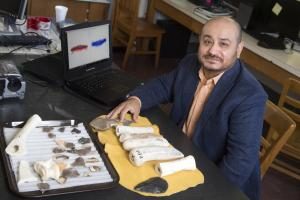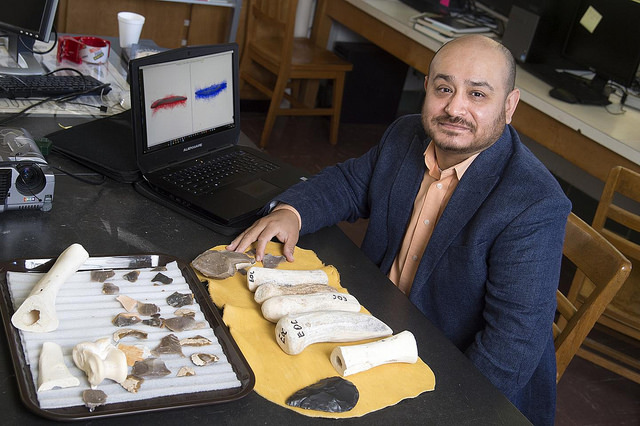
Archaeologist and biostatistician Erik Otárola-Castillo leads the research team that used 3-D imaging, shape analysis and Bayesian statistics to identify butchery cut marks with an 88 percent success rate in classifying butchery behaviors. The 3-D imaging technology is similar to what engineers use to measure scratches on microchips and surgical blade sharpness.
“This approach represents a major improvement in accuracy when compared to many archaeological methods, and improving this technique will help us get the human evolution story correct,” Otárola-Castillo said. “By strengthening quantitative methods to evaluate archaeological evidence, we will be able to learn more about early humans much more quickly.”
The findings are published in the Journal of Archaeological Science. Otárola-Castillo is an assistant professor of the Department of Anthropology.
“In archaeology, butchery marks on animal bones are a key piece of evidence used to answer questions about food acquisition in prehistoric hunter and gatherer populations,” said Otárola-Castillo, who studies hunters-gatherers’ diets to answer questions about human evolution. His expertise spans North American hunters-gatherers archaeology, evolutionary biology, statistics and computational modeling.
Human-made stone tools leave cut marks on animal bone, such as sheep, deer or bison, through butchery. These cut marks can vary in size from 1 to 5 centimeters, but the depth of the cuts is often tiny, measuring at approximately 1/15 of a millimeter. Archaeologists often attempt to distinguish between cut marks made by a human’s stone tool, which leaves a “V” shape, and other damage, such as trampling by a hooved animal, which can leave marks with more of a “U” shape.
Archaeologists have attempted to identify butchering marks since the 1800s. While the methods of analyzing bone marks have improved over the decades, there is still quite a lot of uncertainty and lack of consensus on how they are best measured. Current measurement techniques range from naked eye qualitative assessments to high-powered microscopy, such as scanning electron microscopy or micro-photogrammetry.
Otárola-Castillo and research teammates Emma James from The University of Queensland; Curtis W. Marean from Arizona State University; and Jessica C. Thompson from Emory University, specialize in evaluating cut marks on bone.
There are cases when marks can be ambiguous. In 2010, a couple of research teams published contradicting findings regarding bone marks from a prehistoric site, Dikika in Ethiopia. Results from their analyses varied so much they disagreed whether the marks were made by humans’ tools or animals’ hooves, or perhaps scratched by sand particles or other rock edges. Fresh debate now contends that some of these marks could have been made by feeding crocodiles.
“The tension over this debate has been great, because the source of the cuts matters significantly. If made by stone tools, then this is an example of stone tool-use by some of the earliest human ancestors,” Otárola-Castillo said. “Recently, researchers sent bones with cut marks to various experts for analysis. The goal was to evaluate the convergence of different experts’ assessments of the characteristics of the bone marks using traditional methods. Alarmingly, results showed that the qualitative assessments were inconsistent between all experts. Similar concerns also relate to modern forensics evidence, so our work is a finding that may be of interest to that field as well.”
Otárola-Castillo, Marean, Thompson, and Shannon P. McPherron from the Max Planck Institute for Evolutionary Anthropology, began working on methodological improvements for bone mark analysis in 2010. Other team members are Jacob A. Harris from Arizona State University, Purdue graduate student Melissa G. Torquato and Purdue undergraduate student Hannah C. Hawkins. McPherron and Marean were members of one of the teams evaluating bones from the Dikika site in Ethiopia.
In their new study, Otárola-Castillo and the team used more than 40 cuts and slices made by volunteer butchers on sheep bones using stone tools. A “cut” represents a 90-degree incision angle, and a “slice” represents a 45-degree incision angle. The researchers then measured the cuts with a profilometer, a 3-D microscope that measures topography, roughness and layer thickness in the micro- and nanometer ranges. After measuring them, the researchers conducted a 3-D shape and size analysis of the curves and surfaces to compare the cut marks.
“Once the digital data were compared, we used Bayesian statistics, which provide a quantitative measure of scientific believability. For example, given the evidence, the probability of accurately determining the identity of a mark on a bone is 88 percent in this case,” Otárola-Castillo said.
__________________________________
Archaeologist and biostatistician Erik Otárola-Castillo leads the research team that used 3-D imaging, shape analysis and Bayesian statistics to identify butchery cut marks with an 88 percent success rate in classifying butchery behaviors. The 3D imaging technology is similar to what engineers use to measure scratches on microchips and surgical blade sharpness. The findings are published in the Journal of Archaeological Science.Purdue University photo/Mark Simons
_______________________________________________
Article Source: Purdue University news release
______________________________________________
This research was funded by a variety of sources, including the National Science Foundation, Margo Katherine Wilke Undergraduate Research Fund at Purdue University, Purdue’s College of Liberal Arts ASPIRE, and a grant from the John Templeton Foundation to the Institute of Human Origins at Arizona State University. Purdue’s Department of Anthropology is housed in the College of Liberal Arts.
______________________________________________
Receive 30 days free access to the popular new CuriosityStream lineup of documentaries on science, history, nature, and technology as a new Popular Archaeology premium subscriber.
___________________________________________
Travel and learn with Far Horizons.
______







